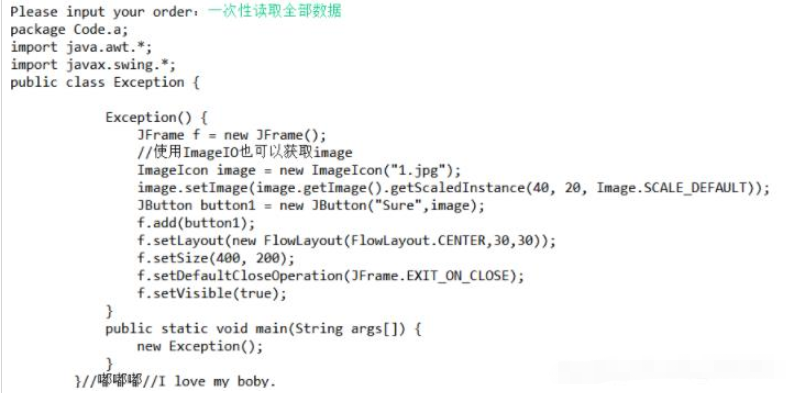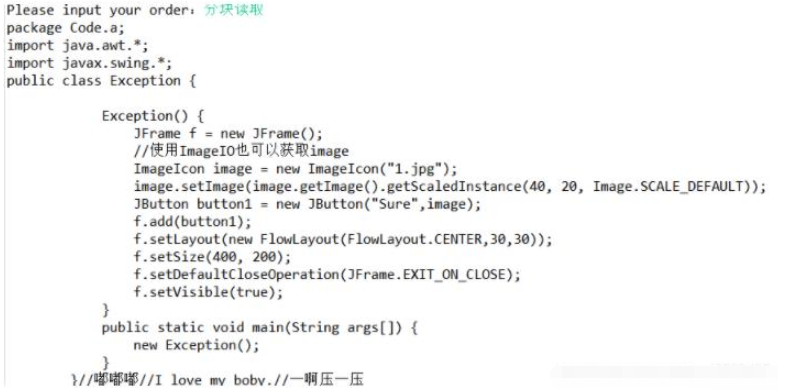这篇文章主要介绍“Java文件操作的方法”的相关知识,小编通过实际案例向大家展示操作过程,操作方法简单快捷,实用性强,希望这篇“Java文件操作的方法”文章能帮助大家解决问题。
简介
本程序主要采用了FileInputStream和FileOutputStream两类对文件进行操作。具体包括通过相对路径打开文件,三种方法读取文件,查看文件属性,追加文件数据等。
效果图:




完整代码:
package Code.a;import java.io.*;public class FileInputStreamDemo { public static void main(String[] args) { //获取当前目录; File f = new File("."); System.out.print("absolute path:"+f.getAbsolutePath()+"\n"); while(true) { try { //输入命令; System.out.print("Please input your order:"); BufferedReader stdinBufferedReader; String str1 = null; stdinBufferedReader = new BufferedReader(new InputStreamReader(System.in)); str1 = stdinBufferedReader.readLine(); //相对路径打开文件; File file2 = new File(".\\src\\Code\\a\\Exception.java"); FileInputStream fis2 = new FileInputStream(file2); 根据不同的命令,执行不同操作; //一次性读取全部数据 if(str1.equals("一次性读取全部数据")) { byte[] buf = new byte[(int)(file2.length())]; fis2.read(buf); String str = new String(buf); System.out.print(str); System.out.print("\n"); } //分块读取 else if(str1.equals("分块读取")) { int n = 1024,count; byte[] buf = new byte[n]; while((count = fis2.read(buf)) != -1) { System.out.print(new String(buf,0,count)); } System.out.print("\n"); } //逐字读取数据 else if(str1.equals("逐字读取数据")) { for(int i = 0; i < file2.length(); i++) { char ch = (char)(fis2.read()); System.out.print(ch); } System.out.print("\n"); } //退出 else if(str1.equals("退出")) { System.out.print("已退出\n"); break; } //查看文件属性 else if(str1.equals("查看文件属性")) { System.out.print("If the file or catalog exists:"+file2.exists()+"\n"); System.out.print("If is it a file:"+file2.isFile()+"\n"); System.out.print("If is it a catalog:"+file2.isDirectory()+"\n"); System.out.print("FileName:"+file2.getName()+"\n"); System.out.print("absolute path:"+file2.getAbsolutePath()+"\n"); System.out.print("The last time that the file was changed:"+file2.lastModified()+"\n"); System.out.print("The size of the file:"+file2.length()+" bites\n"); } //向文件追加数据 else if(str1.equals("文件追加数据")) { FileOutputStream fos2 = new FileOutputStream(file2,true); System.out.println("Please input the content: "); BufferedReader ContentReader; String str2 = null; ContentReader = new BufferedReader(new InputStreamReader(System.in)); str2 = ContentReader.readLine(); fos2.write(str2.getBytes()); fos2.close(); } //关闭流对象; fis2.close(); } //处理异常; catch(FileNotFoundException fnfe) { System.out.print("The file open unsuccessfully."); }catch(IOException ioe) { ioe.printStackTrace(); } } } }关于“Java文件操作的方法”的内容就介绍到这里了,感谢大家的阅读。如果想了解更多行业相关的知识,可以关注编程网行业资讯频道,小编每天都会为大家更新不同的知识点。





